child seat KIA SPECTRA5 2006 Owners Manual
[x] Cancel search | Manufacturer: KIA, Model Year: 2006, Model line: SPECTRA5, Model: KIA SPECTRA5 2006Pages: 273, PDF Size: 2.83 MB
Page 29 of 273
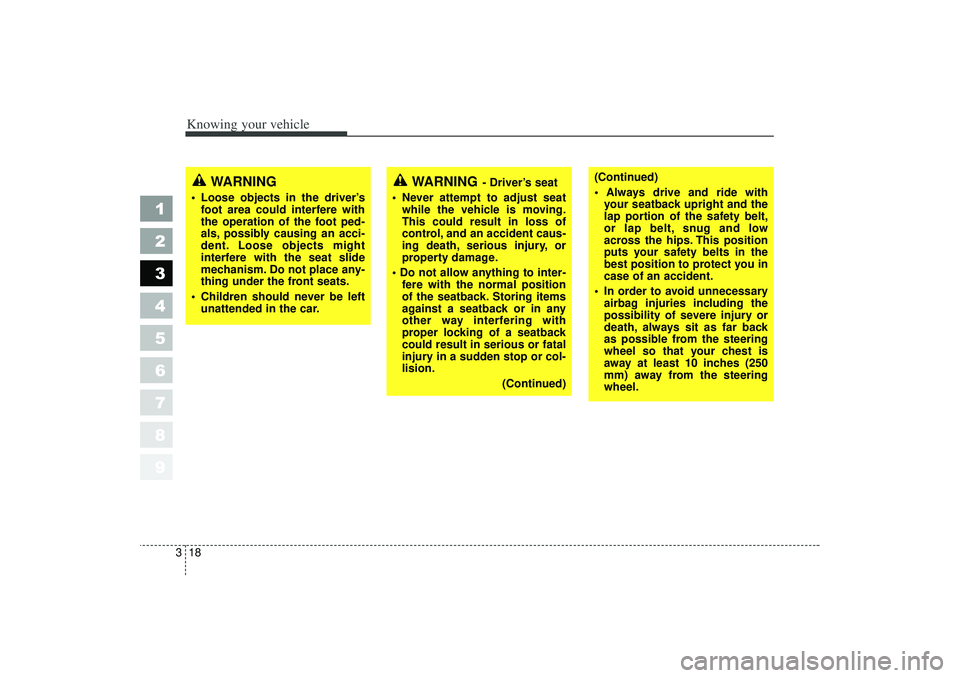
Knowing your vehicle18
3
1
2
3
4
5
6
7
8
9
WARNING
Loose objects in the driver’s
foot area could interfere with
the operation of the foot ped-
als, possibly causing an acci-
dent. Loose objects might
interfere with the seat slide
mechanism. Do not place any-
thing under the front seats.
Children should never be left unattended in the car.
WARNING
- Driver’s seat
Never attempt to adjust seat while the vehicle is moving.
This could result in loss of
control, and an accident caus-
ing death, serious injury, or
property damage.
Do not allow anything to inter- fere with the normal position
of the seatback. Storing items
against a seatback or in any
other way interfering with
proper locking of a seatback
could result in serious or fatal
injury in a sudden stop or col-
lision.
(Continued)
(Continued)
Always drive and ride withyour seatback upright and the
lap portion of the safety belt,
or lap belt, snug and low
across the hips. This position
puts your safety belts in the
best position to protect you in
case of an accident.
In order to avoid unnecessary airbag injuries including the
possibility of severe injury or
death, always sit as far back
as possible from the steering
wheel so that your chest is
away at least 10 inches (250
mm) away from the steering
wheel.
LD CAN (ENG) new 3-1~.qxd 7/29/05 10:28 AM Page 18
Page 32 of 273
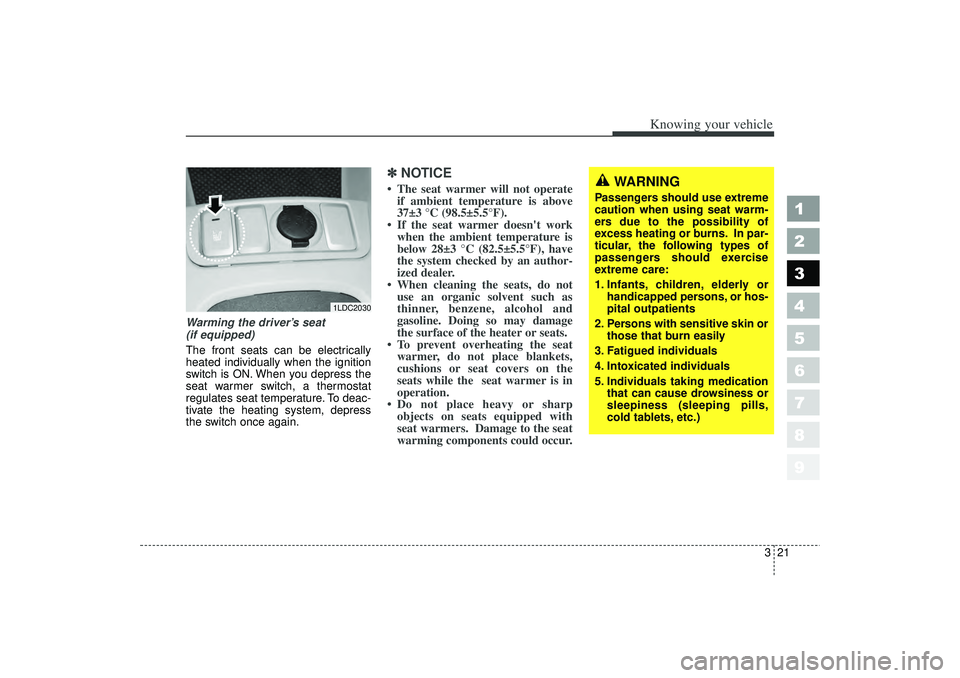
321
1
2
3
4
5
6
7
8
9
Knowing your vehicle
Warming the driver’s seat
(if equipped)
The front seats can be electrically
heated individually when the ignition
switch is ON. When you depress the
seat warmer switch, a thermostat
regulates seat temperature. To deac-
tivate the heating system, depress
the switch once again.
✽ ✽NOTICE The seat warmer will not operate
if ambient temperature is above
37±3 °C (98.5±5.5°F).
If the seat warmer doesn't work when the ambient temperature is
below 28±3 °C (82.5±5.5°F), have
the system checked by an author-
ized dealer.
When cleaning the seats, do not use an organic solvent such as
thinner, benzene, alcohol and
gasoline. Doing so may damage
the surface of the heater or seats.
To prevent overheating the seat warmer, do not place blankets,
cushions or seat covers on the
seats while the seat warmer is in
operation.
Do not place heavy or sharp objects on seats equipped with
seat warmers. Damage to the seat
warming components could occur.
WARNING
Passengers should use extreme
caution when using seat warm-
ers due to the possibility of
excess heating or burns. In par-
ticular, the following types of
passengers should exercise
extreme care:
1. Infants, children, elderly or
handicapped persons, or hos-
pital outpatients
2. Persons with sensitive skin or those that burn easily
3. Fatigued individuals
4. Intoxicated individuals
5. Individuals taking medication that can cause drowsiness or
sleepiness (sleeping pills,
cold tablets, etc.)
1LDC2030
LD CAN (ENG) new 3-1~.qxd 7/29/05 10:28 AM Page 21
Page 42 of 273
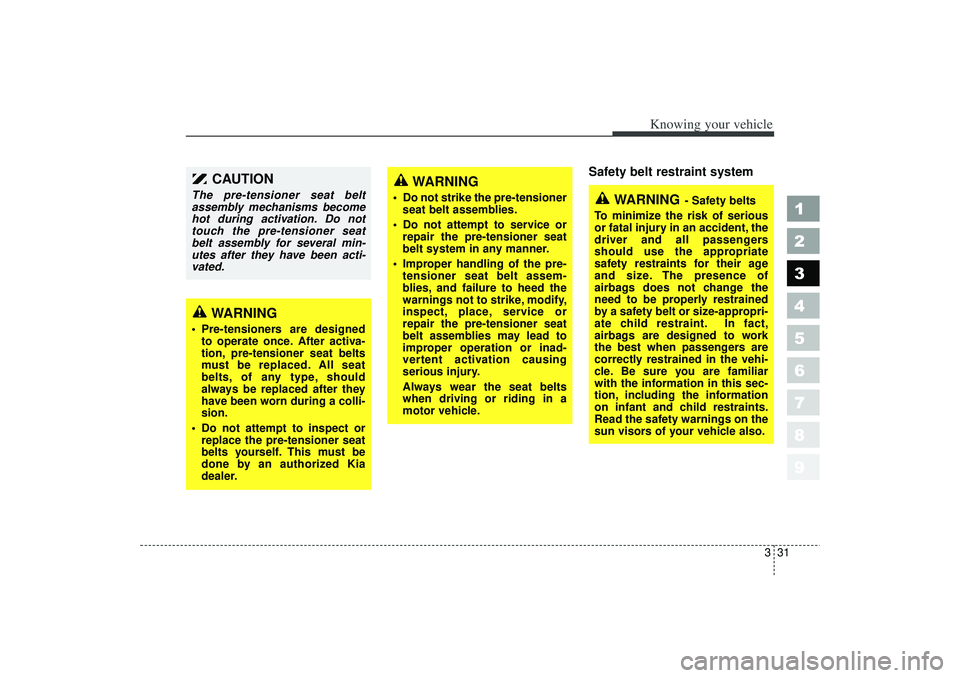
331
1
2
3
4
5
6
7
8
9
Knowing your vehicle
Safety belt restraint system
WARNING
Pre-tensioners are designedto operate once. After activa-
tion, pre-tensioner seat belts
must be replaced. All seat
belts, of any type, should
always be replaced after they
have been worn during a colli-
sion.
Do not attempt to inspect or replace the pre-tensioner seat
belts yourself. This must be
done by an authorized Kia
dealer.
CAUTION
The pre-tensioner seat belt
assembly mechanisms become
hot during activation. Do not
touch the pre-tensioner seat
belt assembly for several min-
utes after they have been acti-
vated.
WARNING
Do not strike the pre-tensionerseat belt assemblies.
Do not attempt to service or repair the pre-tensioner seat
belt system in any manner.
Improper handling of the pre- tensioner seat belt assem-
blies, and failure to heed the
warnings not to strike, modify,
inspect, place, service or
repair the pre-tensioner seat
belt assemblies may lead to
improper operation or inad-
vertent activation causing
serious injury.
Always wear the seat belts
when driving or riding in a
motor vehicle.
WARNING
- Safety belts
To minimize the risk of serious
or fatal injury in an accident, the
driver and all passengers
should use the appropriate
safety restraints for their age
and size. The presence of
airbags does not change the
need to be properly restrained
by a safety belt or size-appropri-
ate child restraint. In fact,
airbags are designed to work
the best when passengers are
correctly restrained in the vehi-
cle. Be sure you are familiar
with the information in this sec-
tion, including the information
on infant and child restraints.
Read the safety warnings on the
sun visors of your vehicle also.
LD CAN (ENG) new 3-1~.qxd 7/29/05 10:28 AM Page 31
Page 43 of 273
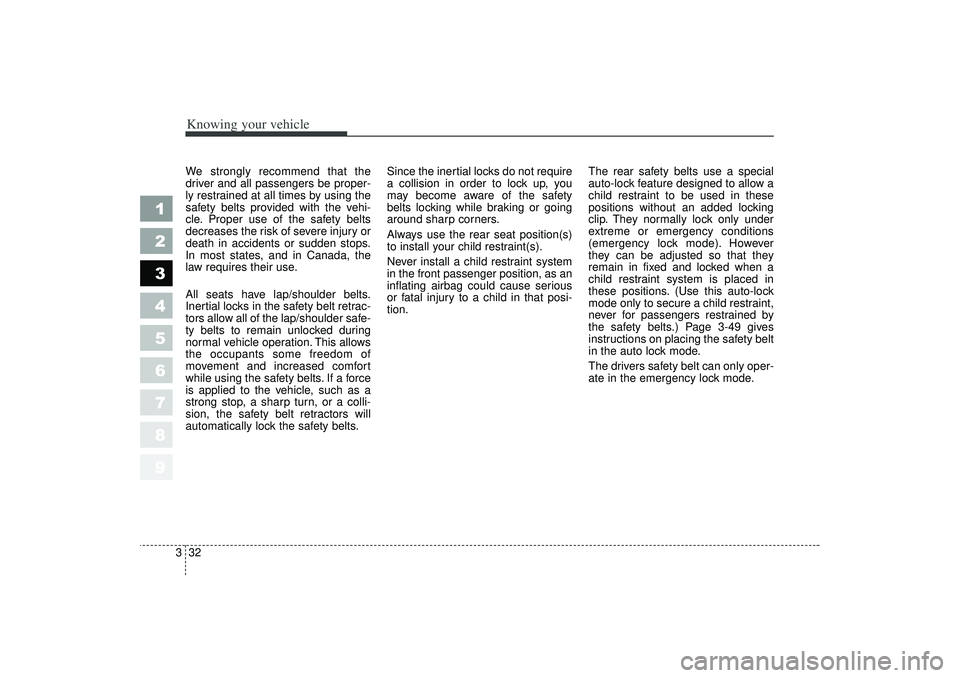
Knowing your vehicle32
3
1
2
3
4
5
6
7
8
9
We strongly recommend that the
driver and all passengers be proper-
ly restrained at all times by using the
safety belts provided with the vehi-
cle. Proper use of the safety belts
decreases the risk of severe injury or
death in accidents or sudden stops.
In most states, and in Canada, the
law requires their use.
All seats have lap/shoulder belts.
Inertial locks in the safety belt retrac-
tors allow all of the lap/shoulder safe-
ty belts to remain unlocked during
normal vehicle operation. This allows
the occupants some freedom of
movement and increased comfort
while using the safety belts. If a force
is applied to the vehicle, such as a
strong stop, a sharp turn, or a colli-
sion, the safety belt retractors will
automatically lock the safety belts. Since the inertial locks do not require
a collision in order to lock up, you
may become aware of the safety
belts locking while braking or going
around sharp corners.
Always use the rear seat position(s)
to install your child restraint(s).
Never install a child restraint system
in the front passenger position, as an
inflating airbag could cause serious
or fatal injury to a child in that posi-
tion.
The rear safety belts use a special
auto-lock feature designed to allow a
child restraint to be used in these
positions without an added locking
clip. They normally lock only under
extreme or emergency conditions
(emergency lock mode). However
they can be adjusted so that they
remain in fixed and locked when a
child restraint system is placed in
these positions. (Use this auto-lock
mode only to secure a child restraint,
never for passengers restrained by
the safety belts.) Page 3-49 gives
instructions on placing the safety belt
in the auto lock mode.
The drivers safety belt can only oper-
ate in the emergency lock mode.
LD CAN (ENG) new 3-1~.qxd 7/29/05 10:28 AM Page 32
Page 54 of 273
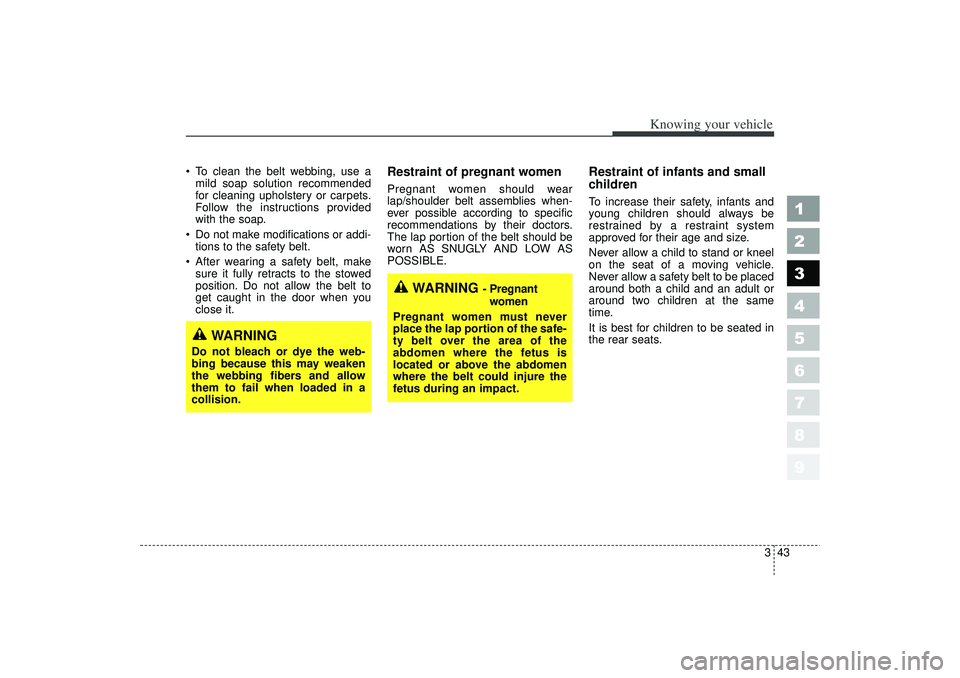
343
1
2
3
4
5
6
7
8
9
Knowing your vehicle
To clean the belt webbing, use a
mild soap solution recommended
for cleaning upholstery or carpets.
Follow the instructions provided
with the soap.
Do not make modifications or addi-
tions to the safety belt.
After wearing a safety belt, make
sure it fully retracts to the stowed
position. Do not allow the belt to
get caught in the door when you
close it.
Restraint of pregnant women Pregnant women should wear
lap/shoulder belt assemblies when-
ever possible according to specific
recommendations by their doctors.
The lap portion of the belt should be
worn AS SNUGLY AND LOW AS
POSSIBLE.
Restraint of infants and small
children To increase their safety, infants and
young children should always be
restrained by a restraint system
approved for their age and size.
Never allow a child to stand or kneel
on the seat of a moving vehicle.
Never allow a safety belt to be placed
around both a child and an adult or
around two children at the same
time.
It is best for children to be seated in
the rear seats.
WARNING
- Pregnant
women
Pregnant women must never
place the lap portion of the safe-
ty belt over the area of the
abdomen where the fetus is
located or above the abdomen
where the belt could injure the
fetus during an impact.
WARNING
Do not bleach or dye the web-
bing because this may weaken
the webbing fibers and allow
them to fail when loaded in a
collision.
LD CAN (ENG) new 3-1~.qxd 7/29/05 10:28 AM Page 43
Page 55 of 273
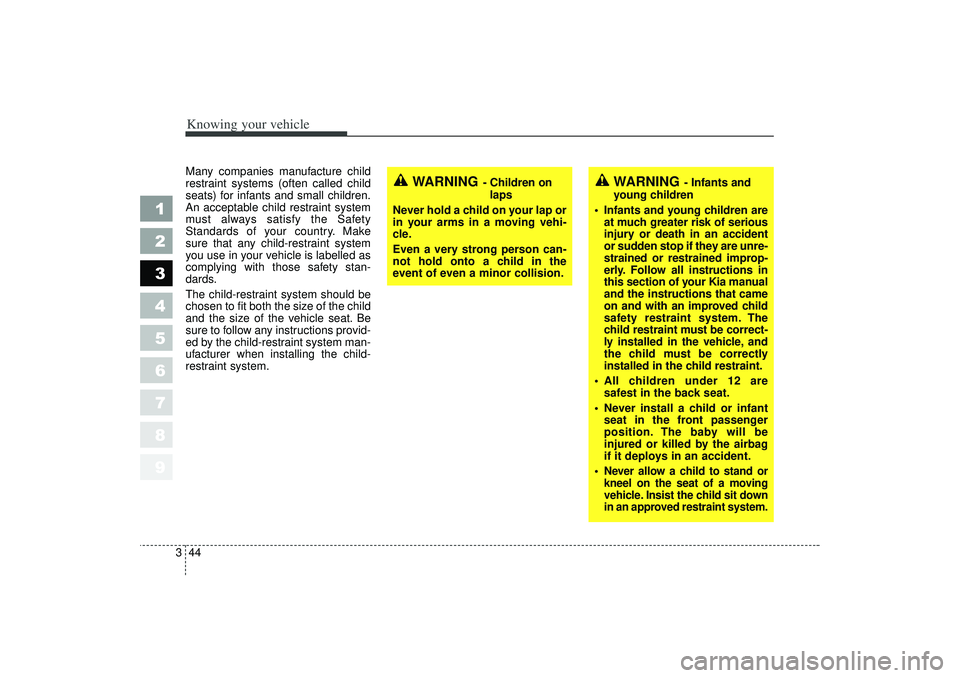
Knowing your vehicle44
3
1
2
3
4
5
6
7
8
9
Many companies manufacture child
restraint systems (often called child
seats) for infants and small children.
An acceptable child restraint system
must always satisfy the Safety
Standards of your country. Make
sure that any child-restraint system
you use in your vehicle is labelled as
complying with those safety stan-
dards.
The child-restraint system should be
chosen to fit both the size of the child
and the size of the vehicle seat. Be
sure to follow any instructions provid-
ed by the child-restraint system man-
ufacturer when installing the child-
restraint system.
WARNING
- Infants and
young children
Infants and young children are at much greater risk of serious
injury or death in an accident
or sudden stop if they are unre-
strained or restrained improp-
erly. Follow all instructions in
this section of your Kia manual
and the instructions that came
on and with an improved child
safety restraint system. The
child restraint must be correct-
ly installed in the vehicle, and
the child must be correctly
installed in the child restraint.
All children under 12 are safest in the back seat.
Never install a child or infant seat in the front passenger
position. The baby will be
injured or killed by the airbag
if it deploys in an accident.
Never allow a child to stand or
kneel on the seat of a moving
vehicle. Insist the child sit down
in an approved restraint system.
WARNING
- Children on laps
Never hold a child on your lap or
in your arms in a moving vehi-
cle.
Even a very strong person can-
not hold onto a child in the
event of even a minor collision.
LD CAN (ENG) new 3-1~.qxd 7/29/05 10:28 AM Page 44
Page 56 of 273
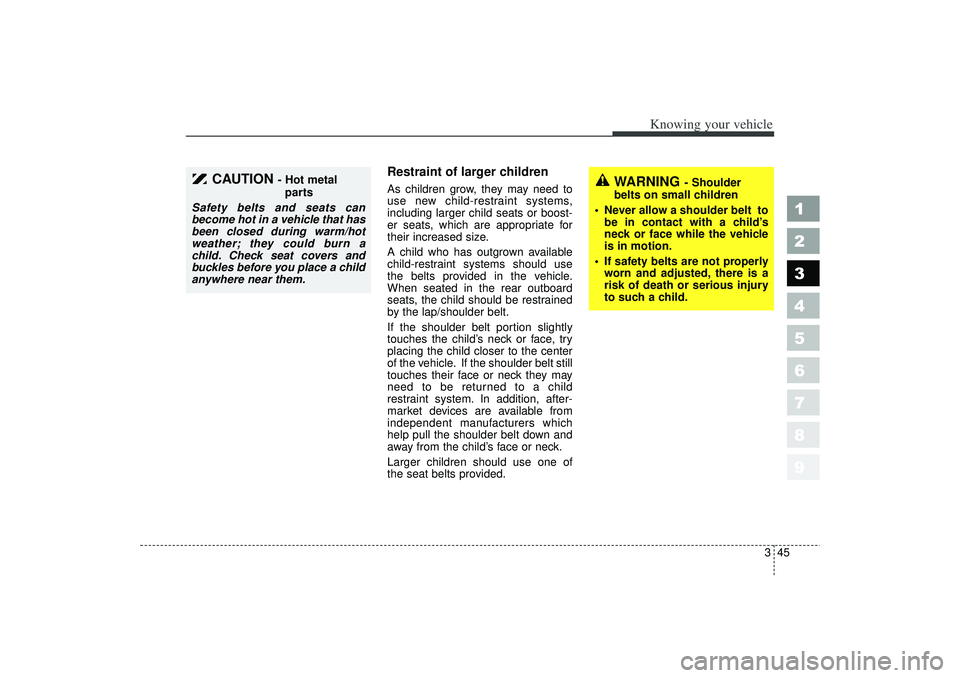
345
1
2
3
4
5
6
7
8
9
Knowing your vehicle
Restraint of larger children As children grow, they may need to
use new child-restraint systems,
including larger child seats or boost-
er seats, which are appropriate for
their increased size.
A child who has outgrown available
child-restraint systems should use
the belts provided in the vehicle.
When seated in the rear outboard
seats, the child should be restrained
by the lap/shoulder belt.
If the shoulder belt portion slightly
touches the child’s neck or face, try
placing the child closer to the center
of the vehicle. If the shoulder belt still
touches their face or neck they may
need to be returned to a child
restraint system. In addition, after-
market devices are available from
independent manufacturers which
help pull the shoulder belt down and
away from the child’ s face or neck.
Larger children should use one of
the seat belts provided.
WARNING
- Shoulder
belts on small children
Never allow a shoulder belt to be in contact with a child’s
neck or face while the vehicle
is in motion.
If safety belts are not properly worn and adjusted, there is a
risk of death or serious injury
to such a child.
CAUTION
- Hot metal
parts
Safety belts and seats can
become hot in a vehicle that has
been closed during warm/hot
weather; they could burn a
child. Check seat covers and
buckles before you place a child
anywhere near them.
LD CAN (ENG) new 3-1~.qxd 7/29/05 10:28 AM Page 45
Page 57 of 273
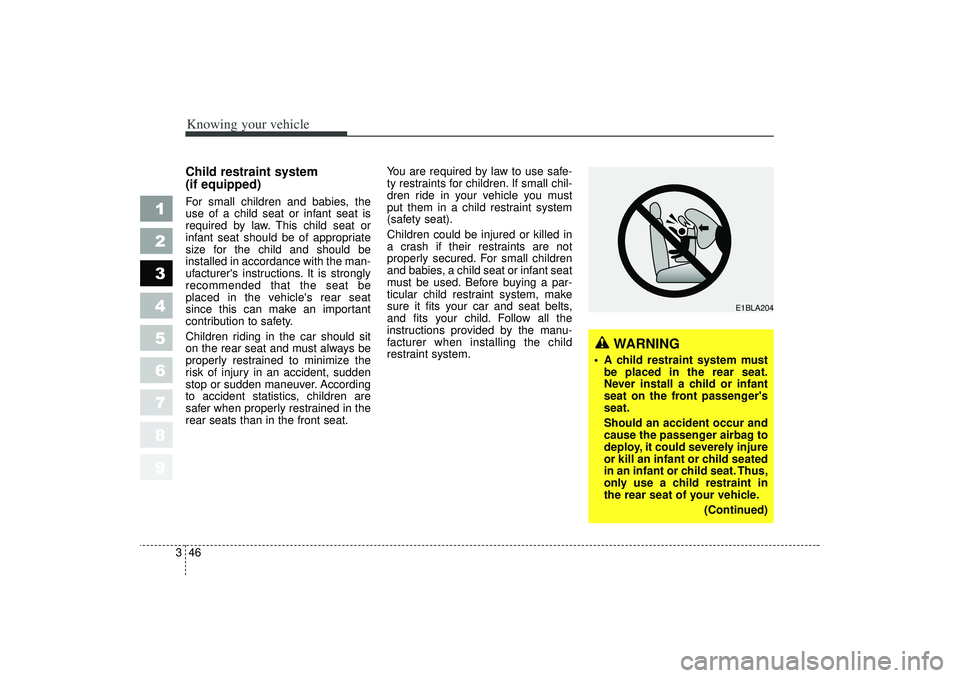
Knowing your vehicle46
3
1
2
3
4
5
6
7
8
9
Child restraint system
(if equipped)For small children and babies, the
use of a child seat or infant seat is
required by law. This child seat or
infant seat should be of appropriate
size for the child and should be
installed in accordance with the man-
ufacturer's instructions. It is strongly
recommended that the seat be
placed in the vehicle's rear seat
since this can make an important
contribution to safety.
Children riding in the car should sit
on the rear seat and must always be
properly restrained to minimize the
risk of injury in an accident, sudden
stop or sudden maneuver. According
to accident statistics, children are
safer when properly restrained in the
rear seats than in the front seat. You are required by law to use safe-
ty restraints for children. If small chil-
dren ride in your vehicle you must
put them in a child restraint system
(safety seat).
Children could be injured or killed in
a crash if their restraints are not
properly secured. For small children
and babies, a child seat or infant seat
must be used. Before buying a par-
ticular child restraint system, make
sure it fits your car and seat belts,
and fits your child. Follow all the
instructions provided by the manu-
facturer when installing the child
restraint system.
E1BLA204
WARNING
A child restraint system must
be placed in the rear seat.
Never install a child or infant
seat on the front passenger's
seat.
Should an accident occur and
cause the passenger airbag to
deploy, it could severely injure
or kill an infant or child seated
in an infant or child seat. Thus,
only use a child restraint in
the rear seat of your vehicle.
(Continued)
LD CAN (ENG) new 3-1~.qxd 7/29/05 10:28 AM Page 46
Page 58 of 273
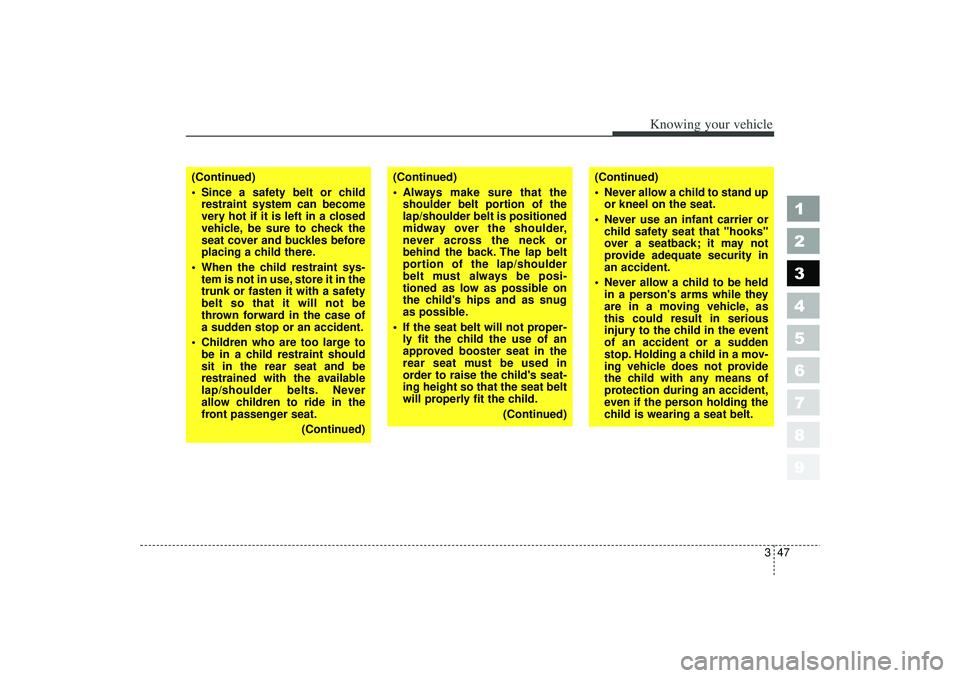
347
1
2
3
4
5
6
7
8
9
Knowing your vehicle
(Continued)
Always make sure that theshoulder belt portion of the
lap/shoulder belt is positioned
midway over the shoulder,
never across the neck or
behind the back. The lap belt
portion of the lap/shoulder
belt must always be posi-
tioned as low as possible on
the child's hips and as snug
as possible.
If the seat belt will not proper- ly fit the child the use of an
approved booster seat in the
rear seat must be used in
order to raise the child's seat-
ing height so that the seat belt
will properly fit the child.
(Continued)
(Continued)
Never allow a child to stand upor kneel on the seat.
Never use an infant carrier or child safety seat that "hooks"
over a seatback; it may not
provide adequate security in
an accident.
Never allow a child to be held in a person's arms while they
are in a moving vehicle, as
this could result in serious
injury to the child in the event
of an accident or a sudden
stop. Holding a child in a mov-
ing vehicle does not provide
the child with any means of
protection during an accident,
even if the person holding the
child is wearing a seat belt.
(Continued)
Since a safety belt or childrestraint system can become
very hot if it is left in a closed
vehicle, be sure to check the
seat cover and buckles before
placing a child there.
When the child restraint sys- tem is not in use, store it in the
trunk or fasten it with a safety
belt so that it will not be
thrown forward in the case of
a sudden stop or an accident.
Children who are too large to be in a child restraint should
sit in the rear seat and be
restrained with the available
lap/shoulder belts. Never
allow children to ride in the
front passenger seat.
(Continued)
LD CAN (ENG) new 3-1~.qxd 7/29/05 10:28 AM Page 47
Page 59 of 273
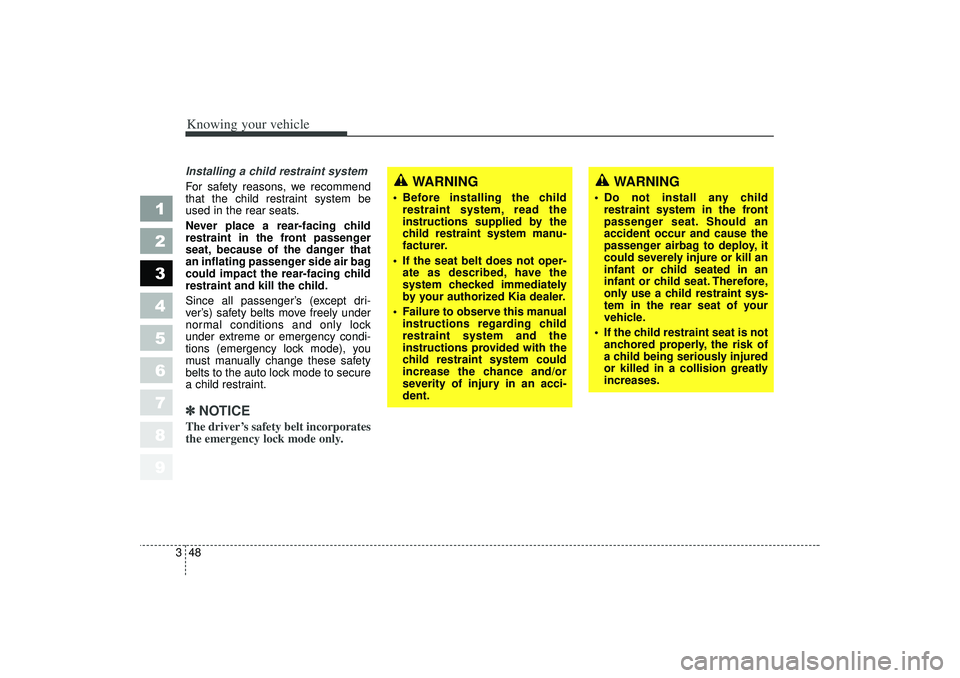
Knowing your vehicle48
3
1
2
3
4
5
6
7
8
9
Installing a child restraint system
For safety reasons, we recommend
that the child restraint system be
used in the rear seats.
Never place a rear-facing child
restraint in the front passenger
seat, because of the danger that
an inflating passenger side air bag
could impact the rear-facing child
restraint and kill the child.
Since all passenger’ s (except dri-
ver ’s) safety belts move freely under
normal conditions and only lock
under extreme or emergency condi-
tions (emergency lock mode), you
must manually change these safety
belts to the auto lock mode to secure
a child restraint.✽ ✽ NOTICEThe driver’s safety belt incorporates
the emergency lock mode only.
WARNING
Do not install any child
restraint system in the front
passenger seat. Should an
accident occur and cause the
passenger airbag to deploy, it
could severely injure or kill an
infant or child seated in an
infant or child seat. Therefore,
only use a child restraint sys-
tem in the rear seat of your
vehicle.
If the child restraint seat is not anchored properly, the risk of
a child being seriously injured
or killed in a collision greatly
increases.
WARNING
Before installing the childrestraint system, read the
instructions supplied by the
child restraint system manu-
facturer.
If the seat belt does not oper- ate as described, have the
system checked immediately
by your authorized Kia dealer.
Failure to observe this manual instructions regarding child
restraint system and the
instructions provided with the
child restraint system could
increase the chance and/or
severity of injury in an acci-
dent.
LD CAN (ENG) new 3-1~.qxd 7/29/05 10:28 AM Page 48